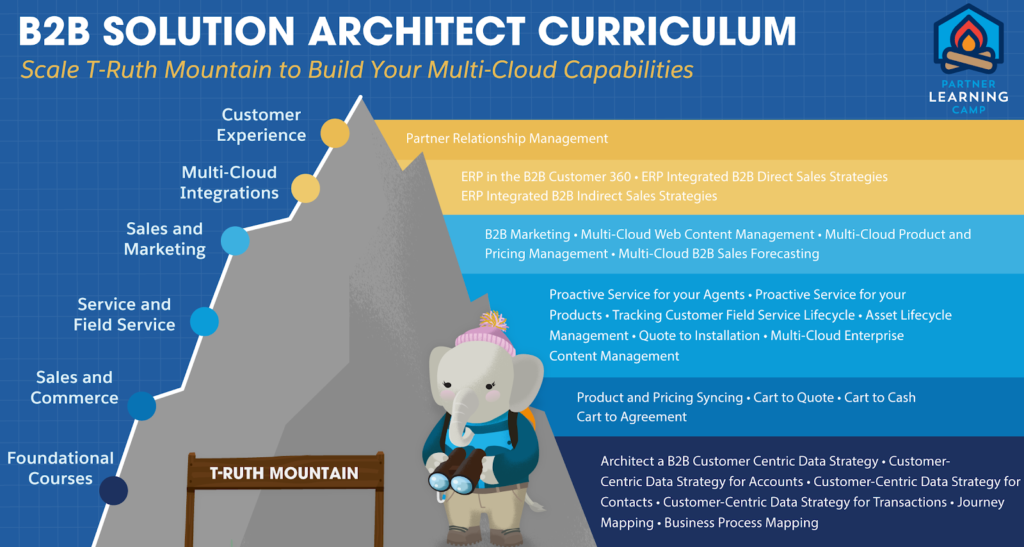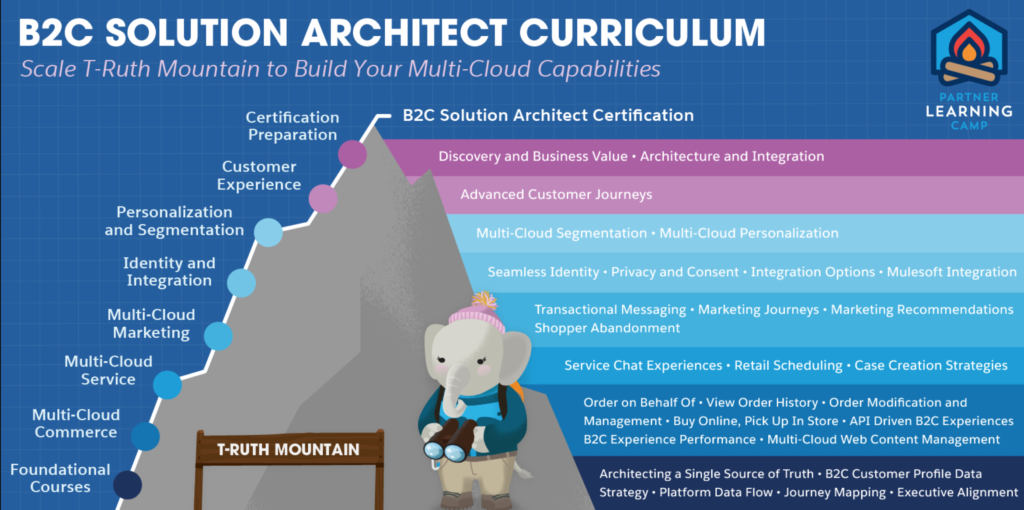What Does a Salesforce Solution Architect Do – And How Do You Become One?
- March 27, 2023
- Pardot Careers, Pardot Consulting, Salesforce Ben | The Drip, Solution Architect
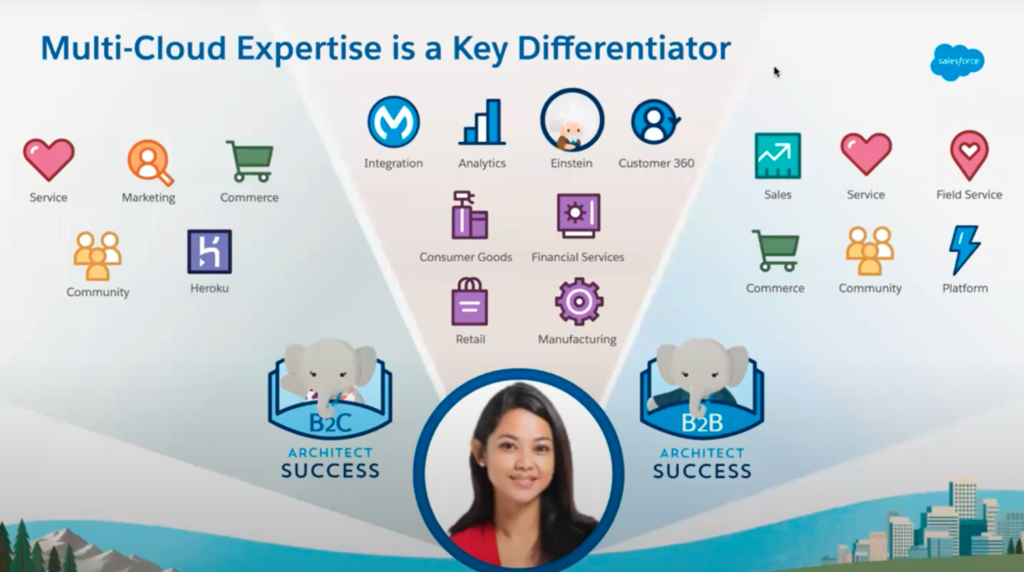
Salesforce Solution Architects are responsible for designing quality, scalable, and performant solutions inside Salesforce, ensuring it all fits together into a coherent and attractive solution. The Solution Architect role has been on the rise in line with the demand for skilled professionals that can look at the wider picture (multi-cloud) when approaching a Salesforce project.
But what does it actually take to become a Solution Architect on the Salesforce platform? And what does the role involve once you are one? I’m Luke, and I have been working with Salesforce for over seven years. I am going to share what I learned on my journey to becoming a Salesforce Solution Architect, the core skills you should possess, and how you can get started.
What Is a Salesforce Solution Architect?
Simply put, Salesforce Solution Architects are responsible for the ‘solution’. They also prepare data for sending to other systems and process data when it’s received from other systems.
They will oversee:
- Data modeling
- Data migration
- Data sharing
- Multi-component solutions
- Salesforce configuration (and the consultants working on the configuration)
- Connected apps
- Declarative automation
- User experience (UX)
- Handoff to other systems
- Environment management
- Deployments
- Leading a team of consultants and/or administrators
Solution Architects versus Enterprise Architects: Enterprise Architects look at a whole system landscape and multiple technologies, whereas Solution Architects mainly focus their efforts on Salesforce (although, this does not necessarily mean it is a simpler role!)
Solution Architects versus Technical Architects: Technical Architects usually work deeper into the architecture and understand the implementation from a technical level. In contrast, a Solution Architect sits at a higher level, but still with an understanding of the solution. You will often hear a Solution Architect working alongside a Technical Architect.
However, the lines are often blurred when it comes to roles and responsibilities. Ultimately the size of the implementation usually decides which level of architecture role you would need:
- For smaller implementations, a single Solution Architect can be sufficient.
- For larger ones, enterprise projects usually demand multiple Technical/Solution/Enterprise architects due to the complexity.
Fact: Did you know that 85% of Solution Architects work as Salesforce partners?
B2B vs. B2C Solution Architects
The reason for the B2B and B2C split boils down to how your customers sell, market, and support their customers. Multi-cloud is the norm now. That’s why Salesforce is not creating disparate Community Cloud Architect or Field Service Architect learning pathways and role labels.
This how the Salesforce platform is categorized between the two:

Not so fast! Traditionally, B2B or B2C use cases pointed towards a specific product; as organizations have innovated, and the Salesforce platform has expanded, the lines separating each have blurred. This is why learning with use cases comes into the light – in other words, how do you make products work together in context?
Can Anyone Become a Solution Architect?
Short answer: Yes. However, in reality, it’s not an easy role to reach.
I originally thought that Solution Architects came up with the solution, then the delivery team delivered it, and that was it. I will admit now that I was wrong. There are many skills that a Salesforce Solution Architect must possess to be successful (not just limited to Salesforce skills, which we will cover later in the guide).
Anyone familiar with the Salesforce Architect remit will know that these roles, with all their nuances, cannot be learned from pure study alone. Becoming a Salesforce Architect is part experience, part deep knowledge of best practice, and part instinct, to some degree.
Becoming a Solution Architect requires more than following traditional training modules. Instead, preparing for this role requires enablement that is driven by delivery and implementation guidance and best practices. You can compare this to the opposite approach, narrowed study of features, and functionality.
I had always been technical-minded. When I first started my Salesforce career, I planned to reach the coveted CTA role (Certified Technical Architect). I wanted to become the youngest CTA within the Salesforce ecosystem. I will admit, this was ambitious!
As my career progressed, I found myself becoming less interested in the technical aspects, and more interested in the solution as a whole. I naturally moved into the Solution Architect role – and I love my job.
10 Salesforce Solution Architect Skills
Both technical Salesforce skills, as well as soft skills are imperative to fulfill the Solution Architect role. Here are my top picks:
- Passion for Salesforce: First, you must love Salesforce. You are designing and delivering the best possible solution for your clients, and be certain that what you’re proposing is bulletproof. You need to know exactly what Salesforce is capable of and what it is not capable of. This comes with experience, but you must be prepared to learn Salesforce inside out and keep up to date with the releases.
- Solid Understanding of Best Practice: Coming up with a solution is relatively easy – but you must absolutely follow best practices. You do not want to design and implement something which is going to break as soon as your team leaves.
- Teamwork: You will likely be working alongside Business Analysts/Consultants/Architects, and you must communicate with each other well.
- Leadership: As a Solution Architect, you are one of the senior members of the project team. You are ultimately responsible for whether that project succeeds or fails based on your decisions and solution. You must be able to lead your team but allow them the freedom to do their jobs and grow in their own careers.
- Communication: Clear and concise communication is key. If your team or client does not understand what you are trying to achieve, then your project is going to fail. Always understand your audience.
- Personable: Building a good rapport with both your client and team is essential for successful project delivery. We sometimes work in stressful environments, and enjoying yourself along the way does not harm anyone – as long as you are delivering quality work.
- Trusted: Instilling trust with both your team and client is essential. Your client wants to know that if you have agreed to deliver something, it will be delivered on time of the expected quality.
- Ability to Problem Solve: Problems can arise at any time on any project. How you deal with, and overcome those problems, involves being able to communicate effectively about what the problem is, and what the proposed solutions are. Do not be afraid to admit mistakes to your clients, they will be appreciative of your transparency.
- Mentor Mindset: Bringing the whole team up with you is what makes a great team player and a great architect. Sharing your wealth of knowledge with more junior team members is highly rewarding for them, and for you.
- Ability to Keep Calm: There is a lot of pressure on Solution Architects to deliver quality work. Your client, your team, your company – they are all looking to you. There will be times when it can be overwhelming, but leading by example is key. If everyone else sees you stressing, they are likely to start getting stressed themselves.
Become a Salesforce Solution Architect
Solution Architect Learning Expeditions
For budding Solution Architects, Salesforce provides Learning Expeditions for both B2B Solution Architects, and B2C Solution Architects. These collections of training modules guide you through preparing for the real-world demands expected of Salesforce Architects.
Note: Learning Labs are only available to partners (you must have access to the Partner Learning Camp).
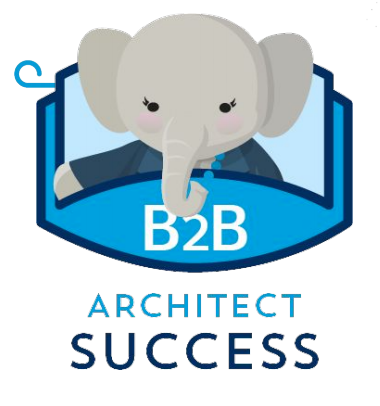
You’ll be climbing what Salesforce calls T-Ruth Mountain (named after Ruth, the elephant), from foundational courses to covering sales, commerce, and more:
The Learning Expeditions are outlined in this handy PDF, including links to the Partner Learning Camp. The Learning Expedition overviews follow the format ‘If you know [this Salesforce Cloud] and want to learn [that Salesforce Cloud]’ – for example, ‘If you know B2B Commerce and want to learn Service Cloud’.
More details on the courses are available in this PDF (page 25 onwards).
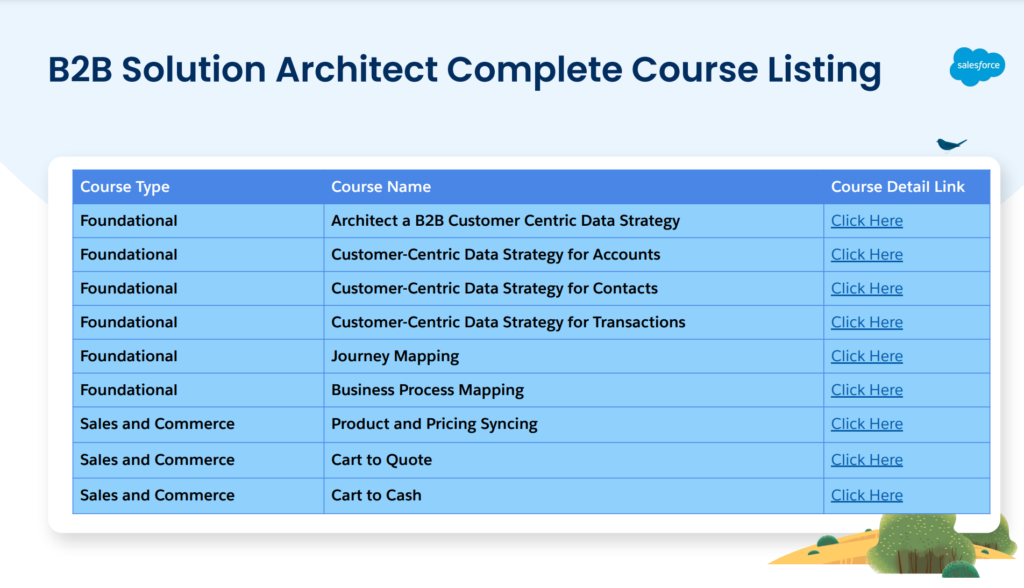
The Salesforce Solution Architect learning journeys are exceptional – made for architects, by architects, with a good deal of passion thrown into the mix. The program takes a new approach to enablement, driven by delivery and implementation guidance and best practices. In fact, this new vision for Salesforce enablement extends company-wide, the first of many future pathways rolled out in this way.
For Trailblazers who don’t have access, and want to get a taste of what it takes to become a B2B Solution Architect – check out the B2B Solution Architect Trailmix and B2C Solution Architect Trailmix, publicly available on Trailhead.
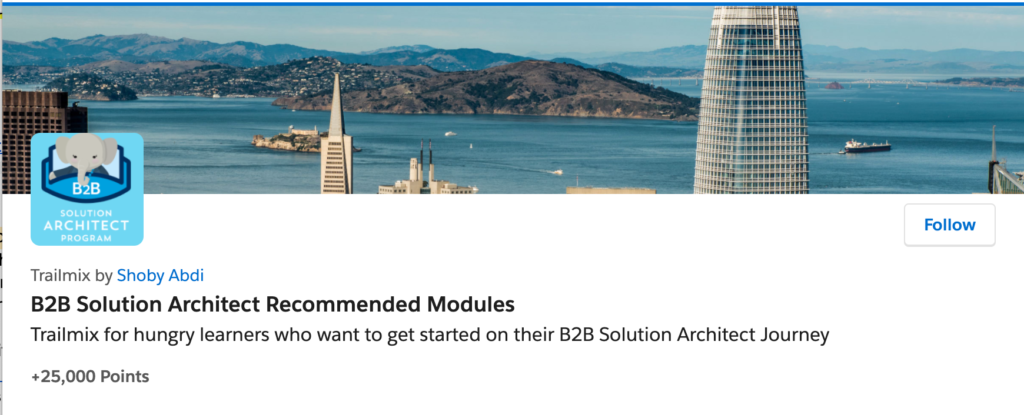
Solution Architect Learning Labs
Learning Labs are hands-on training sessions that complement the Learning Expeditions. You can find the eight Learning Labs outlined on the infographic. Again, these are only available to anyone with access to the Partner Learning Camp.
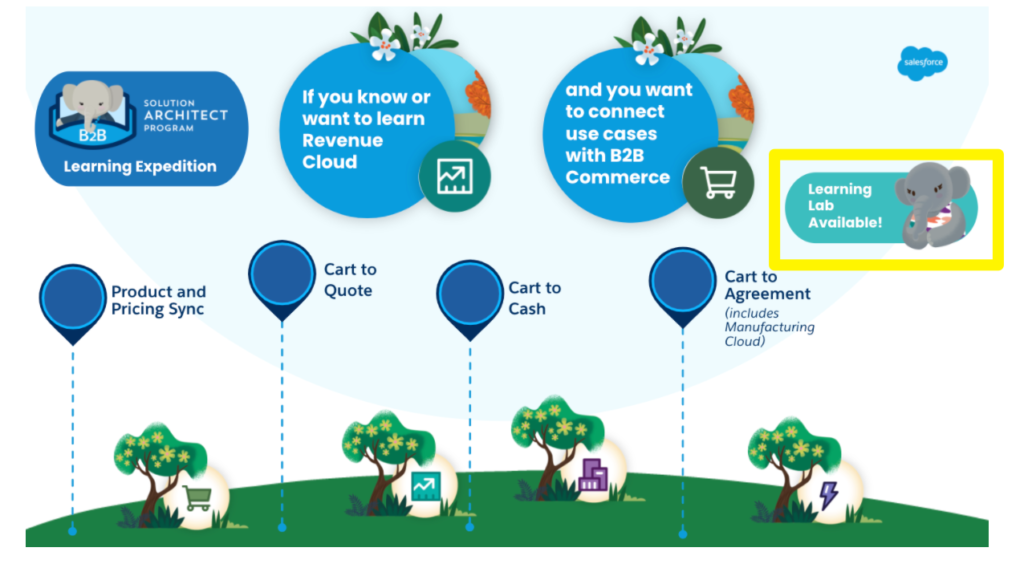
Learning Through Use Cases
Solution Architect study should be focused on use cases. Learning with use cases means that, as an architect, you will be equipped to sort through the jumbled mess a real human consumer makes in their customer journey. You will be able to transform the left-hand side back-end complexity into the right-hand seamless consumer experience:

Salesforce Solution Architect Certification: Pyramid
There are three ‘certified’ architect pathways: Technical, Application, and System. The pyramid outlines the route, including prerequisites. These certifications are slightly trickier and come with a higher price tag and a higher pass mark, compared to other certifications.
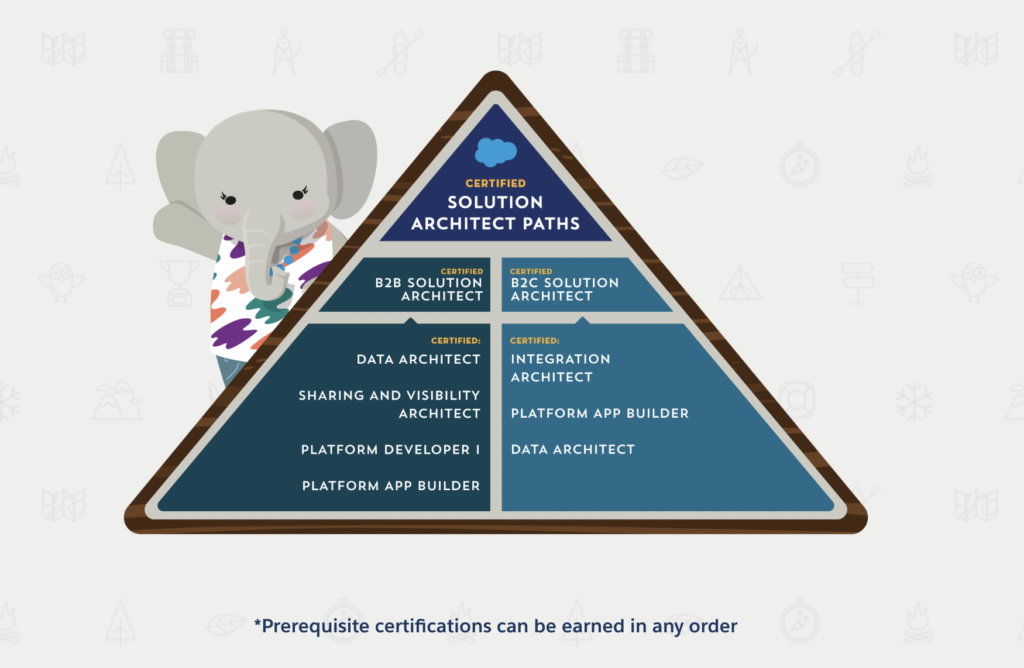
Solution Architect
- B2C Solution Architect: For architects who have the knowledge, skills, and experience architecting and driving multi-cloud solutions (functional/technical experience with B2C Commerce Cloud, Marketing Cloud, and Sales, Service, or Experience Clouds).
- B2B Solution Architect: For architects who have the knowledge, skills, and experience architecting and driving multi-cloud solutions (functional/technical experience with B2B Commerce, Sales Cloud, Service Cloud, Marketing Cloud, Pardot, Revenue Cloud, Field Service, Einstein Automate, Experience Cloud, CRM Analytics – formerly Tableau CRM, and MuleSoft).
Application Architect
The less ‘technical’ side of the pyramid, focused on the fundamentals of any Salesforce implementation. Once you have passed these four exams, you are classified as an Application Architect, which I think is great for Salesforce Solution Architects to achieve.
Data Architect: Understanding your data model, and how you build scalable and enterprise-level data management solutions.
Sharing and Visibility Architect: Understanding our sharing model, who sees what within Salesforce environments.
Platform Developer and Platform App Builder: Putting everything into practice, again focusing on the fundamentals of any Salesforce implementation.
System Architect
The more ‘technical’ side of the pyramid. Once you have passed these four exams, you are classified as a System Architect.
Development Lifecycle and Deployment Architect: All about the process of doing any development work – from build through to packaging and deployment best practice.
Identity and Access Management Architect: Understanding who is accessing your Salesforce environment – internally and externally, as well as what level of access they have.
Integration Architect: Design integrations in the best possible way, using the correct integration patterns, and correct tools to achieve it.
Platform Developer: Putting everything into practice as a developer.
Salesforce Solution Architect: Common Challenges
Stepping into a Solution Architect role definitely has its challenges. Here are some of the ones I faced when moving from a Consultant role to a Solution Architect.
- Pressure: As you step into more senior roles, there is a lot more pressure from everyone for you to deliver, and to deliver well. If you are someone who does not deal well with pressure, then the role is probably not for you.
- Keeping up to date on everything Salesforce: Salesforce technology constantly evolves. With three releases each year, it’s easy to fall out of the loop. Ensure you are reading release notes, blogs, videos, etc. so that you remain on top.
- Not building anything: I love configuring Salesforce. As you progress into more senior roles, you take a step back from the configuration. This in ties with the challenge above; I learn a lot faster when doing something, so it was difficult for me to adapt. Trailhead is a great way to remain up-to-date and keep your configuration skills relevant.
- Confidence: I struggled with confidence when I first started my career. When you’re in less senior roles, you’ll be okay to not say anything in meetings (absorbing all the information). However, when you’re a Solution Architect, the client is paying a significant amount of money, and they expect to get their money’s worth in terms of advice. Coming across confident in what you are saying is key.
- Time Management: Something else I struggled with! You are delivering projects to tight timescales. Not only do you need to manage your own time, but also your team’s time to ensure you can hit your milestones.
This isn’t an exhaustive list of challenges you could face. So much will depend on the environment you work in. Solution Architects who are delivering enterprise-level projects will face challenges to those delivering smaller-sized projects. The ones listed above could apply to any project size.
Is The Solution Architect Role Right For Me?
So, how do you know if this role is right for you? You must be willing to put in time and effort. I worked my way from an apprentice, fresh out of college, through to administrator, consultant, and now Solution Architect. Experience is everything; I am continuing to learn every single day, and no two days are the same.
You must be adaptable. Consulting is a whirlwind; one day you could be up north delivering a demo, the next down south assisting on a sales pitch. If you do not enjoy a constantly changing environment, then pursue another role which would suit you better.
You need to expect to be thrown in at the deep end. This is what will force you to work on your soft skills. There have been times during my career where I’ve found myself in a ‘sink or swim’ situation. If someone had told me years ago to demo to 20 people, I would have respectfully declined! Except, in this role, I had no choice. Take any opportunity which is thrown your way!
Lastly, you need to enjoy yourself. I have met some great people and had some great memories during my career. If you can be a great Solution Architect, and enjoy yourself along the way, it will not even feel like you are working.
Summary
Hopefully, this post has enlightened you about the world of Salesforce Solution Architects – and hopefully, even inspired you to become one. As I mentioned, I fell into this role accidentally, but I thoroughly enjoy what I do!
If you do not enjoy what you do, you’re going to end up demotivated, and it will hinder you from delivering to the best of your ability. And be ready for the challenges – they are all a part of the job!
This Pardot article written by:
Salesforce Ben | The Drip
Lucy Mazalon is the Head Editor & Operations Director at Salesforceben.com, Founder of THE DRIP and Salesforce Marketing Champion 2020.
Original Pardot Article: https://www.salesforceben.com/what-is-a-salesforce-solution-architect/
Find more great Pardot articles at www.salesforceben.com/the-drip/
Pardot Experts Blog
We have categorized all the different Pardot articles by topics.
Pardot Topic Categories
- Account Based Marketing (ABM) (7)
- Business Units (14)
- ChatGPT / AI (3)
- Completion Actions (5)
- Connectors (10)
- Custom Redirects (4)
- Data Cloud (3)
- Demand Generation (8)
- Dynamic Content (7)
- Einstein Features (11)
- Email Delivery (17)
- Email Open Rates (3)
- Pardot A/B Testing (2)
- Email Mailability (16)
- Do Not Email (1)
- Double Opt-in (2)
- Opt Out / Unsubscribe (14)
- Email Preferences Page (6)
- Engagement Studio (16)
- Industries (1)
- Non Profit (1)
- Landing Pages (9)
- Lead Generation (1)
- Lead Management (13)
- Lead Routing (3)
- Lead Scoring (16)
- Leads (3)
- Marketing Analytics – B2BMA (9)
- Marketing Automation (1)
- Marketing Cloud (3)
- Marketing Cloud Account Engagement (4)
- Marketing Cloud Growth (2)
- New Pardot Features (6)
- Opportunities (2)
- Optimization (2)
- Pardot Admin (65)
- Duplicates (1)
- Marketing Ops (1)
- Pardot Alerts (1)
- Pardot API (2)
- Pardot Automations (3)
- Pardot Careers (12)
- Pardot Certifications (4)
- Pardot Consulting (1)
- Pardot Cookies (4)
- Pardot Custom Objects (3)
- Pardot Email Builder (8)
- Pardot Email Templates (10)
- HML (6)
- Pardot Events (17)
- Pardot External Actions (1)
- Pardot External Activities (4)
- Pardot Forms (29)
- Form Handlers (8)
- Pardot Integrations (21)
- Data Cloud (2)
- Slack (1)
- Pardot Lead Grading (5)
- Pardot Lead Source (2)
- Pardot Lightning (1)
- Pardot Migration (1)
- Pardot Nurture / Drip Campaigns (2)
- Pardot Personalization (3)
- Pardot Profiles (1)
- Pardot Releases (18)
- Pardot Sandboxes (2)
- Pardot Segmentation (5)
- Pardot Strategy (7)
- Pardot Sync (2)
- Pardot Sync Errors (1)
- Pardot Tracker Domains (5)
- Pardot Training (3)
- Pardot Vs Other MAPs (4)
- Pardot Website Tracking (2)
- Reporting (22)
- Salesforce and Pardot (31)
- Marketing Data Sharing (2)
- Pardot Users (3)
- Salesforce Automation (5)
- Salesforce Flows (2)
- Salesforce Campaigns (22)
- Salesforce CRM (3)
- Record Types (1)
- Salesforce Engage (3)
- Salesforce Queues (2)
- Security and Privacy (1)
- Tags (3)
- The Authors (540)
- Cheshire Impact (9)
- Greenkey Digital (55)
- Invado Solutions (37)
- Jenna Molby (9)
- Marcloud Consulting (6)
- Nebula Consulting (67)
- Pardot Geeks (44)
- Salesforce Ben | The Drip (242)
- SalesLabX (16)
- Slalom (4)
- Unfettered Marketing (51)
- Uncategorized (1)
- Website Tracking (2)
- Website Search (1)
More Pardot Articles
See all posts
This Pardot article written by:
Salesforce Ben | The Drip
Lucy Mazalon is the Head Editor & Operations Director at Salesforceben.com, Founder of THE DRIP and Salesforce Marketing Champion 2020.
Original Pardot Article: https://www.salesforceben.com/what-is-a-salesforce-solution-architect/
Find more great Pardot articles at www.salesforceben.com/the-drip/

